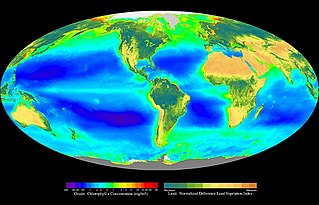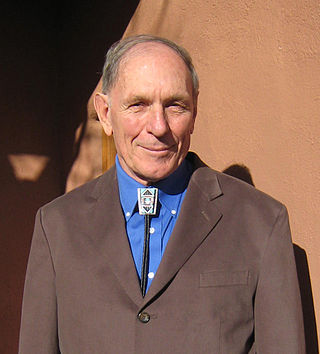
The biosphere, also known as the ecosphere, is the worldwide sum of all ecosystems. It can also be termed the zone of life on Earth. The biosphere is virtually a closed system with regard to matter, with minimal inputs and outputs. Regarding energy, it is an open system, with photosynthesis capturing solar energy at a rate of around 130 terawatts per year. By the most general biophysiological definition, the biosphere is the global ecological system integrating all living beings and their relationships, including their interaction with the elements of the lithosphere, cryosphere, hydrosphere, and atmosphere. The biosphere is postulated to have evolved, beginning with a process of biopoiesis or biogenesis, at least some 3.5 billion years ago.

Biosphere 2 is an American Earth system science research facility located in Oracle, Arizona. Its mission is to serve as a center for research, outreach, teaching, and lifelong learning about Earth, its living systems, and its place in the universe. It is a 3.14-acre (1.27-hectare) structure originally built to be an artificial, materially closed ecological system, or vivarium. It remains the largest closed ecological system ever created.
John Todd is a Canadian biologist working in the general field of ecological design. He addresses problems of food production and wastewater processing by using ecosystems technologies that incorporate plants, animals and bacteria. Todd has developed "Arks" or "bioshelters", ecologically closed "life-support systems" with the goal of sustainable functioning. He combines alternative technologies for renewable energy, organic farming, aquaculture, hydroponics and architecture to create "living machines" or "eco-machines".

Biogeochemistry is the scientific discipline that involves the study of the chemical, physical, geological, and biological processes and reactions that govern the composition of the natural environment. In particular, biogeochemistry is the study of biogeochemical cycles, the cycles of chemical elements such as carbon and nitrogen, and their interactions with and incorporation into living things transported through earth scale biological systems in space and time. The field focuses on chemical cycles which are either driven by or influence biological activity. Particular emphasis is placed on the study of carbon, nitrogen, sulfur, iron, and phosphorus cycles. Biogeochemistry is a systems science closely related to systems ecology.
BIOS-3 is an experimental closed ecosystem at the Institute of Biophysics in Krasnoyarsk, Russia.

Technogaianism is a bright green environmentalist stance of active support for the research, development and use of emerging and future technologies to help restore Earth's environment. Technogaianists argue that developing safe, clean, alternative technology should be an important goal of environmentalists.
Controlledecological life-support systems are a self-supporting life support system for space stations and colonies typically through controlled closed ecological systems, such as the BioHome, BIOS-3, Biosphere 2, Mars Desert Research Station, and Yuegong-1.

Ecological engineering uses ecology and engineering to predict, design, construct or restore, and manage ecosystems that integrate "human society with its natural environment for the benefit of both".

The Georgia O'Keeffe Museum is dedicated to the artistic legacy of Georgia O'Keeffe, her life, American modernism, and public engagement. It opened on July 17, 1997, eleven years after the artist's death. It comprises multiple sites in two locations: Santa Fe, New Mexico, and Abiquiu, New Mexico. In addition to the founding Georgia O'Keeffe Museum in Santa Fe, the O'Keeffe includes: the Library and Archive within its research center at the historic A.M. Bergere house; the Education Annex for youth and public programming; Georgia O'Keeffe's historic Abiquiu Home and Studio; the O'Keeffe Welcome Center in Abiquiu; and Museum Stores in both Santa Fe and Abiquiu. Georgia O'Keeffe's additional home at the Ghost Ranch property is also part of the O'Keeffe Museum's assets, but is not open to the public.
Ecotechnology is an applied science that seeks to fulfill human needs while causing minimal ecological disruption, by harnessing and manipulating natural forces to leverage their beneficial effects. Ecotechnology integrates two fields of study: the 'ecology of technics' and the 'technics of ecology,' requiring an understanding of the structures and processes of ecosystems and societies. All sustainable engineering that can reduce damage to ecosystems, adopt ecology as a fundamental basis, and ensure conservation of biodiversity and sustainable development may be considered as forms of ecotechnology.
Simon Asher Levin is an American ecologist and the James S. McDonnell Distinguished University Professor in Ecology and Evolutionary Biology and the director of the Center for BioComplexity at Princeton University. He specializes in using mathematical modeling and empirical studies in the understanding of macroscopic patterns of ecosystems and biological diversities.

John Polk Allen is a systems ecologist, engineer, metallurgist, adventurer, and writer. Allen is a proponent of the science of biospherics and a pioneer in sustainable co-evolutionary development. He is the founder of Synergia Ranch, and is best known as the inventor and director of research of Biosphere 2, the world's largest vivarium and research facility to study global ecology. Biosphere 2 set multiple records in closed ecological systems work, including degree of sealing tightness, 100% waste and water recycle, and duration of human residence within a closed system. He is also involved with forestry and reforestation in Puerto Rico where he owns a 1000 acre Mahogany tree farm at Patillas.
Edward Perry "Ed" Bass is an American businessman, financier, philanthropist and environmentalist who lives in Fort Worth, Texas. He financed the Biosphere 2 project, an artificial closed ecological system, which was built between 1987 and 1991. He is the chairman of Fine Line, an investment and venture-capital management firm in Fort Worth, and Chairman of the board of directors of the Sid W. Richardson Foundation, a philanthropic organization. He was listed as #239 on the Forbes 400 list of wealthiest Americans in 2012, with an estimated net worth of $2 billion.
Microcosms are artificial, simplified ecosystems that are used to simulate and predict the behaviour of natural ecosystems under controlled conditions. Open or closed microcosms provide an experimental area for ecologists to study natural ecological processes. Microcosm studies can be very useful to study the effects of disturbance or to determine the ecological role of key species. A Winogradsky column is an example of a microbial microcosm.
Synergia Ranch is an ecovillage founded in 1969 by John P. Allen, the inventor of Biosphere 2 and Marie Harding, its present manager. It is located in Santa Fe County, New Mexico, 15 miles south of the city of Santa Fe. Synergia Ranch operates as a private retreat and workshop center for small groups.

Mark Nelson is an American ecologist and author based in Santa Fe, New Mexico. His research focuses on closed ecological system research, ecological engineering, restoration of damaged ecosystems, and wastewater recycling. The founding director of the Institute of Ecotechnics in 1973, Nelson was one of the eight original crew members of Biosphere 2 in 1991 and served as the Director of Earth and Space Applications for the project until 1994.
Kathelin Gray is an American director, writer and curator working across many forms. She has co-founded numerous projects which integrate ecology, science and culture. She writes and speaks on the intersection of art and the sciences.
Niwot Ridge is an alpine ecology research station located 65 km north-west of Denver in north-central Colorado. It is on the Front Range of the southern Rocky Mountains and lies within the Roosevelt National Forest. Niwot Ridge is 2,900 metres (9,500 ft) high.
Theater of All Possibilities (TOAP), was an artistic practice network and touring theater founded in 1967 by John Allen, Kathelin Gray and Marie Harding in San Francisco, California, United States. The group worked with collaborators from the sciences, technology, history, and ecology, with the Institute of Ecotechnics as a partner organization on many projects.
Omar Fayed is an environmentalist and publisher. He is CEO of ESTEE, based in Switzerland and Britain, that advocates human space exploration, space colonization, and sustainable human development within the biosphere. He is co-founder and CEO of EarthX, a data visualization and mapping company based on NASA’s World Wind Project. He is chairman of Synergetic Press based in New Mexico, and a fellow of the Institute of Ecotechnics.








